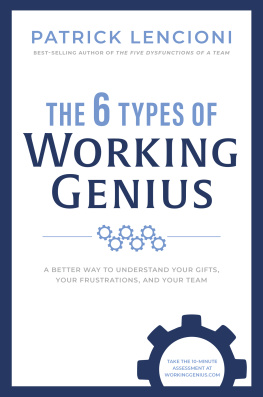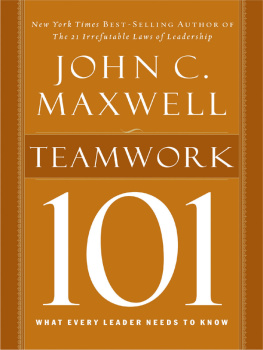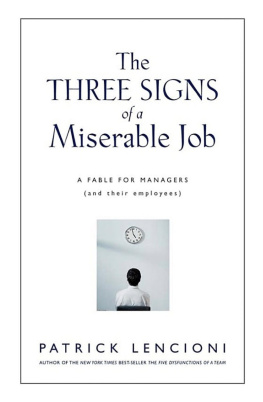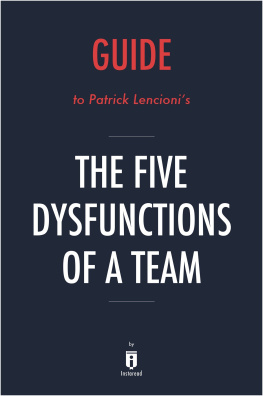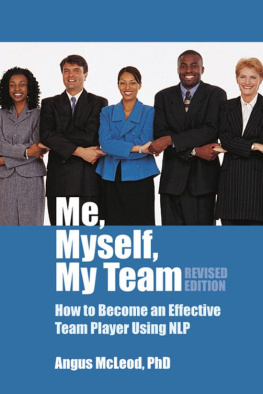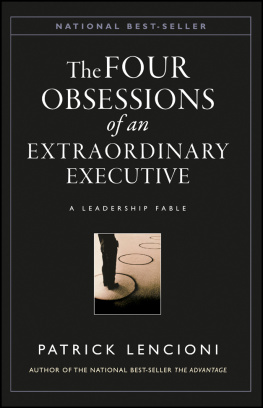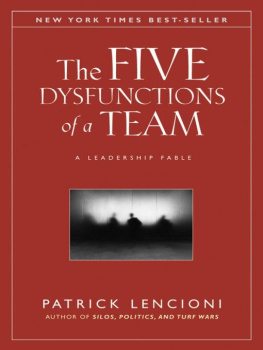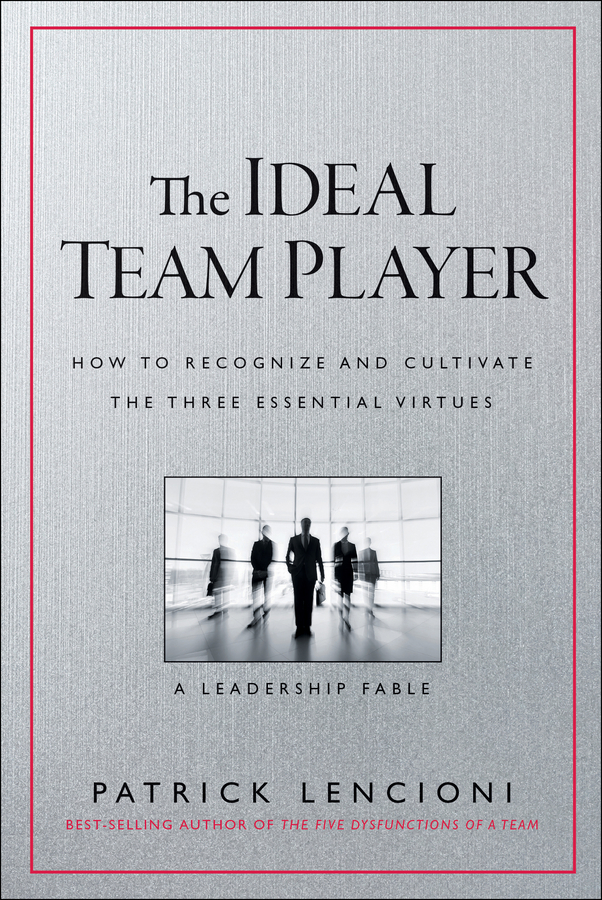
Also by Patrick Lencioni
The Five Temptations of a CEO
The Four Obsessions of an Extraordinary Executive
The Five Dysfunctions of a Team
Death By Meeting
Overcoming the Five Dysfunctions of a Team
Silos, Politics, and Turf Wars
The Truth About Employee Engagement
The Three Big Questions for a Frantic Family
Getting Naked
The Advantage
Cover image: iStock.com / ulkan (background); iStock.com / mediaphotos (inset)
Cover design: Wiley
Copyright 2016 by Patrick Lencioni. All rights reserved.
Published by Jossey-Bass
A John Wiley & Sons, Inc. imprint, Hoboken, New Jersey.
Published simultaneously in Canada.
No part of this publication may be reproduced, stored in a retrieval system, or transmitted in any form or by any means, electronic, mechanical, photocopying, recording, scanning, or otherwise, except as permitted under Section 107 or 108 of the 1976 United States Copyright Act, without either the prior written permission of the Publisher, or authorization through payment of the appropriate per-copy fee to the Copyright Clearance Center, 222 Rosewood Drive, Danvers, MA 01923, (978) 750-8400, fax (978) 646-8600, or on the web at www.copyright.com. Requests to the Publisher for permission should be addressed to the Permissions Department, John Wiley & Sons, Inc., 111 River Street, Hoboken, NJ 07030, (201) 748-6011, fax (201) 748-6008, or online at www.wiley.com/go/permissions.
Limit of Liability/Disclaimer of Warranty: While the publisher and author have used their best efforts in preparing this book, they make no representations or warranties with respect to the accuracy or completeness of the contents of this book and specifically disclaim any implied warranties of merchantability or fitness for a particular purpose. No warranty may be created or extended by sales representatives or written sales materials. The advice and strategies contained herein may not be suitable for your situation. You should consult with a professional where appropriate. Neither the publisher nor the author shall be liable for damages arising herefrom.
For general information about our other products and services, please contact our Customer Care Department within the United States at (800) 762-2974, outside the United States at (317) 572-3993 or fax (317) 572-4002.
Wiley publishes in a variety of print and electronic formats and by print-on-demand. Some material included with standard print versions of this book may not be included in e-books or in print-on-demand. If this book refers to media such as a CD or DVD that is not included in the version you purchased, you may download this material at http://booksupport.wiley.com. For more information about Wiley products, visit www.wiley.com.
ISBN 9781119209591 (cloth); ISBN 9781119209607 (ebk); ISBN 9781119209614 (ebk)
Dedication
This is dedicated to Tracy Noble, who guided me through the process of writing this book, and who lives humble, hungry, and smart every day.
Introduction
If someone were to ask me to make a list of the most valuable qualities a person should develop in order to thrive in the world of workand for that matter, lifeI would put being a team player at the top. The ability to work effectively with others, to add value within the dynamics of a group endeavor, is more critical in today's fluid world than it has ever been. Few people succeed at work, in the family, or in any social context without it.
I'm sure that most people would agree with this, which is why it's a little surprising that great team players are somewhat rare. I think the problem is that we've failed to define what being a team player requires, which leaves the concept somewhat vague, even soft.
It's not unlike teamwork itself, which still gets more lip service than practical attention. In my book, The Five Dysfunctions of a Team, I explained that real teamwork requires tangible, specific behaviors: vulnerability-based trust, healthy conflict, active commitment, peer-to-peer accountability, and a focus on results. Thankfully, with enough coaching, patience, and time, most people can learn to embrace those concepts.
However, I must admit that some people are better at being team players, at embracing those five behaviors, than others. They're not born that way, but either through life experiences, work history, or a real commitment to personal development, they come to possess the three underlying virtues that enable them to be ideal team players: they are humble, hungry, and smart. As simple as those words may appear, none of them is exactly what they seem. Understanding the nuances of these virtues is critical for applying them effectively.
During the past twenty years of working with leaders and their teams, I've seen time and again that when a team member lacks one or more of these three virtues, the process of building a cohesive team is much more difficult than it should be, and in some cases, impossible. We've been using this approach for hiring and management at The Table Group since our founding in 1997, and it has proven to be a remarkable predictor of success, as well as a reliable explanation of failure. As a result, we've come to the conclusion that these three seemingly obvious qualities are to teamwork what speed, strength, and coordination are to athleticsthey make everything else easier.
The ramifications of all this are undeniable. Leaders who can identify, hire, and cultivate employees who are humble, hungry, and smart will have a serious advantage over those who cannot. They'll be able to build stronger teams much more quickly and with much less difficulty, and they'll significantly reduce the painful and tangible costs associated with politics, turnover, and morale problems. And employees who can embody these virtues will make themselves more valuable and marketable to any organization that values teamwork.
The purpose of this little book is to help you understand how the elusive combination of these three simple attributes can accelerate the process of making teamwork a reality in your organization or in your life so you can more effectively achieve the extraordinary benefits that it brings.
I hope it serves you well.
The Fable
Part One

The Situation
Enough
After twenty years, Jeff Shanley had experienced more than his fair share of the Silicon Valley. The hours. The traffic. The pretentiousness. It was time to make a change.
To be fair, it wasn't really the work that Jeff had grown tired of. In fact, he had enjoyed an interesting and successful career. After a few jobs in high-tech marketing, at age thirty-five he cofounded a technology start-up. Two years later, he was fortunate enough to get demoted when the board of directors hired what they called a grown-up CEO. During the next four years, that CEO, Kathryn Petersen, taught Jeff more about leadership, teamwork, and business than he could have learned in a decade of business school.
When Kathryn retired, Jeff left the company and spent the next few years working at a small consulting firm in Half Moon Bay, over the hills from the Silicon Valley. Jeff thrived there, and was on the verge of becoming a partner. But during that time, he and his wife began to grow tired of trying to keep up with the Joneses, which happened to be the name of the family that lived in the over-priced bungalow next door.
Jeff was definitely ready for a change. Where he would go and what he would do next was a mystery to him. He certainly didn't expect the answer to come via a phone call from his uncle Bob.
Next page

